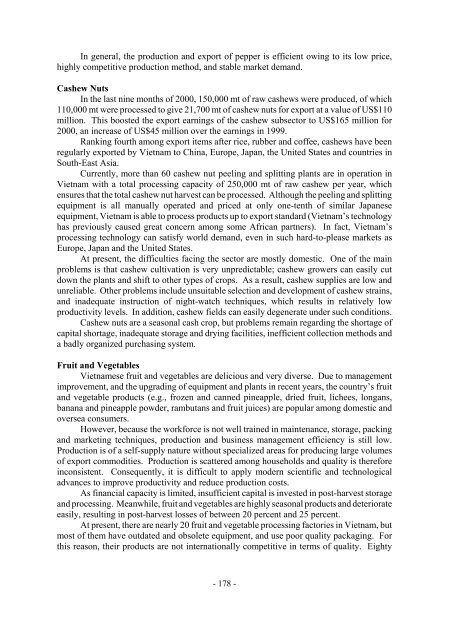Development of Agribusiness Enterprises - Asian Productivity ...
Development of Agribusiness Enterprises - Asian Productivity ...
Development of Agribusiness Enterprises - Asian Productivity ...
You also want an ePaper? Increase the reach of your titles
YUMPU automatically turns print PDFs into web optimized ePapers that Google loves.
In general, the production and export <strong>of</strong> pepper is efficient owing to its low price,<br />
highly competitive production method, and stable market demand.<br />
Cashew Nuts<br />
In the last nine months <strong>of</strong> 2000, 150,000 mt <strong>of</strong> raw cashews were produced, <strong>of</strong> which<br />
110,000 mt were processed to give 21,700 mt <strong>of</strong> cashew nuts for export at a value <strong>of</strong> US$110<br />
million. This boosted the export earnings <strong>of</strong> the cashew subsector to US$165 million for<br />
2000, an increase <strong>of</strong> US$45 million over the earnings in 1999.<br />
Ranking fourth among export items after rice, rubber and c<strong>of</strong>fee, cashews have been<br />
regularly exported by Vietnam to China, Europe, Japan, the United States and countries in<br />
South-East Asia.<br />
Currently, more than 60 cashew nut peeling and splitting plants are in operation in<br />
Vietnam with a total processing capacity <strong>of</strong> 250,000 mt <strong>of</strong> raw cashew per year, which<br />
ensures that the total cashew nut harvest can be processed. Although the peeling and splitting<br />
equipment is all manually operated and priced at only one-tenth <strong>of</strong> similar Japanese<br />
equipment, Vietnam is able to process products up to export standard (Vietnam’s technology<br />
has previously caused great concern among some African partners). In fact, Vietnam’s<br />
processing technology can satisfy world demand, even in such hard-to-please markets as<br />
Europe, Japan and the United States.<br />
At present, the difficulties facing the sector are mostly domestic. One <strong>of</strong> the main<br />
problems is that cashew cultivation is very unpredictable; cashew growers can easily cut<br />
down the plants and shift to other types <strong>of</strong> crops. As a result, cashew supplies are low and<br />
unreliable. Other problems include unsuitable selection and development <strong>of</strong> cashew strains,<br />
and inadequate instruction <strong>of</strong> night-watch techniques, which results in relatively low<br />
productivity levels. In addition, cashew fields can easily degenerate under such conditions.<br />
Cashew nuts are a seasonal cash crop, but problems remain regarding the shortage <strong>of</strong><br />
capital shortage, inadequate storage and drying facilities, inefficient collection methods and<br />
a badly organized purchasing system.<br />
Fruit and Vegetables<br />
Vietnamese fruit and vegetables are delicious and very diverse. Due to management<br />
improvement, and the upgrading <strong>of</strong> equipment and plants in recent years, the country’s fruit<br />
and vegetable products (e.g., frozen and canned pineapple, dried fruit, lichees, longans,<br />
banana and pineapple powder, rambutans and fruit juices) are popular among domestic and<br />
oversea consumers.<br />
However, because the workforce is not well trained in maintenance, storage, packing<br />
and marketing techniques, production and business management efficiency is still low.<br />
Production is <strong>of</strong> a self-supply nature without specialized areas for producing large volumes<br />
<strong>of</strong> export commodities. Production is scattered among households and quality is therefore<br />
inconsistent. Consequently, it is difficult to apply modern scientific and technological<br />
advances to improve productivity and reduce production costs.<br />
As financial capacity is limited, insufficient capital is invested in post-harvest storage<br />
and processing. Meanwhile, fruit and vegetables are highly seasonal products and deteriorate<br />
easily, resulting in post-harvest losses <strong>of</strong> between 20 percent and 25 percent.<br />
At present, there are nearly 20 fruit and vegetable processing factories in Vietnam, but<br />
most <strong>of</strong> them have outdated and obsolete equipment, and use poor quality packaging. For<br />
this reason, their products are not internationally competitive in terms <strong>of</strong> quality. Eighty<br />
- 178 -
















